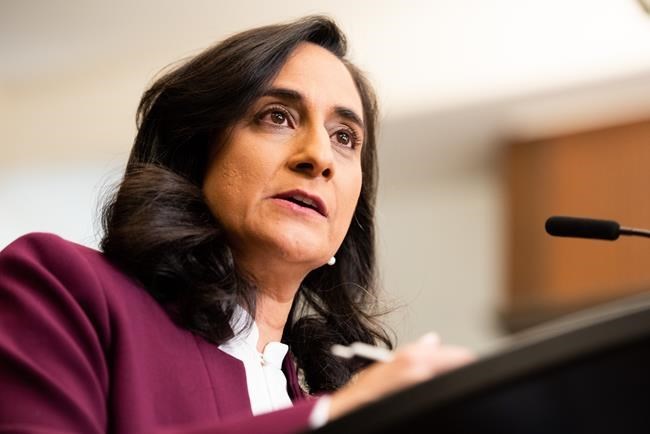WASHINGTON ‚Äî Canada is fortifying a long-standing front in its ongoing battle with protectionist impulses in the United States: resurrecting the Second World War-era notion of the two continental allies working together to stockpile the arsenal of democracy.¬Ý
Defence Minister Anita Anand and Economic Development Minister Fran√ßois-Philippe Champagne are joining forces in the U.S. capital, selling the idea that Canada's nascent critical minerals industry makes it an ideal partner in fortifying a North American defence industrial base.¬Ý
The appearance last week of what U.S. officials say was a Chinese surveillance balloon travelling through the continent's airspace drives home the importance of the two countries working together on national security, the pair said in an interview.
Gen. Glen VanHerck, commander of the binational defence system known as Norad, acknowledged Monday that it wasn't the first such balloon to enter U.S. airspace ‚Äî and that previous incursions went undetected, exposing a "domain awareness gap" that needs closing.¬Ý
"Most definitely, this incident demonstrates the need to invest in our continental defence, which is exactly what we're doing," Anand said, citing the ongoing, $40-billion effort to upgrade a system military leaders have long insisted is desperately outdated.
There's no evidence that any previous Chinese balloons spotted over the U.S. ‚Äî at least four of them, reportedly, including three while Donald Trump was president and another since Joe Biden took over ‚Äî entered Canadian airspace, she added.¬Ý
"We will certainly ensure that our close relationship with the United States continues, in order to contribute to the overall protection and security of the North American continent."
Anand, who has been talking about Norad modernization since becoming defence minister in October 2021, offered few details on the timeline, except to say that work on infrastructure upgrades and state-of-the-art "over the horizon" radar systems is already underway.¬Ý
"These are massive investments," she said. "We will have more details to share soon on how various projects are moving forward."
It was in the superheated blast furnace of the Second World War, with both countries still reeling from the aftermath of the Great Depression and suddenly called upon to develop a collective war effort, that the modern-day industrial ties between Canada and the U.S. were forged.¬Ý
Today, following the COVID-19 pandemic, the global push to back Ukraine in its ongoing war with Russia ‚Äîcombined with the western world's sudden scramble to end its dependence on China for semiconductors, critical minerals and rare earth metals ‚Äî has created an ominous echo.¬Ý
"When you talk to CEOs around the world, they tell you that geopolitics is almost half of the talk they have at their board meetings now, because if you make the wrong pick, that could have devastating consequences," Champagne said.¬Ý
"At a time where nations are striving to build resiliency in their supply chains, I think Canada and the United States stand out in the world with the most integrated supply chain."
The two ministers spoke just hours before Biden's second state of the union address Tuesday evening, a raucous, combative speech that not only showcased America's partisan divisions, but demonstrated that with a presidential election in the offing, the politics of protectionism are alive and well in the White House.¬Ý
"Buy American has been the law since 1933. But for too long, past administrations ‚Äî Democrat and Republican ‚Äî have fought to get around it. Not anymore," the president said to spirited applause.¬Ý
He also promised new rules for federal infrastructure projects that would require all construction materials — not just iron and steel, but copper, aluminum, lumber, glass, drywall and fibre-optic cable — be made in the U.S.
"On my watch, American roads, American bridges and American highways will be made with American products."¬Ý
That kind of rhetoric may be why, with Canada already enshrined as an important supplier to U.S. defence procurement, Ottawa is redoubling its focus on promoting bilateral military co-operation.
"Canada has this vibrant ecosystem of suppliers (that) produce high-quality and reliable parts and components and systems and subsystems. And those systems all enable major weapons platforms," Anand said.¬Ý
"We are at a time in the global economic environment where the demand for munitions and the demand for military equipment and supplies is vastly exceeding supply. We need to make sure that Canada is well-positioned to ensure that we can maintain these stable supply chains."¬Ý
The two ministers will arrive in D.C. late Wednesday for meetings with major U.S. contractors like Lockheed Martin, Boeing, Raytheon and General Dynamics, and will also sit down with key lawmakers on Capitol Hill to remind them how much Canadian content already supports the American military.¬Ý
On Friday, they'll take part in a panel discussion at the Wilson Center on fostering national security and economic prosperity.¬Ý
"This is a time where ... the aerospace and defence industry in particular need to look north," Champagne said.
"We're going there to say, 'Listen, this is an opportunity to team up together, to do more together, innovate more and sell more together.'"
This report by The Canadian Press was first published Feb. 8, 2023.
James McCarten, The Canadian Press




